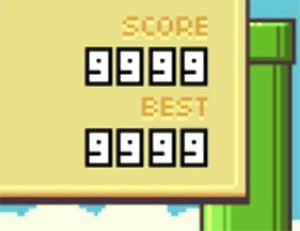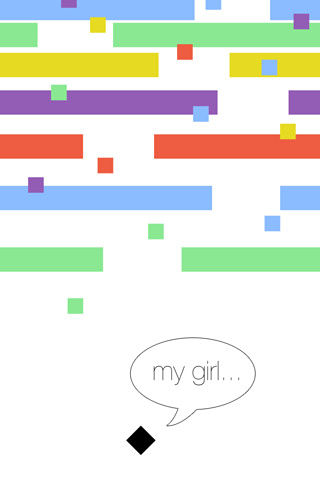8 reasons for the addictiveness of minimalistic games
The creative director of A-Steroids Ilya Eremeev said App2Top.ru about eight reasons for the popularity of minimalistic games, like the “live classics” Flappy Bird and the most recent Amazing Brick.
I scored 209 points in Flappy Bird and got to level 40 in Amazing Brick. It cost me a lot of effort and time. Both games are not distinguished by bright graphics or deep gameplay. So why did I and millions of other players waste my nerves and my time on them? Let’s figure it out.
I have identified eight reasons why these and similar games (Iron Pants, Timberman, Do not Touch Spikes, piano tiles and others) are so sticky.
1. “Primitive” gameplayTo explain what the player needs to do, just one line or even a word on the start screen is enough.
The rules are extremely simple, but in order to achieve a high result, you will have to hone your skills in their implementation. Easy to learn, hard to master – the classic design principle as it is!
2. Ultrashort sessionsIn such games, the user performs a huge number of repetitions of the same type of actions.
The shorter the session, the easier it is to repeat it. I can do a 10-second run several hundred times a day, a run a couple of minutes long will cause nausea after the third time. This is the secret of any grind.
3. Three goalsThe endless nature of the gameplay and the lack of a formulated goal allow the player to create goals for himself and an incentive to continue playing.
When there is only one parameter from the methods of evaluating success – the score, you can set at least three goals:
- The short goal is to improve your result. This is the easiest goal to achieve, and the satisfaction of achieving it comes quite often, especially at the beginning of the game.
- The average goal is to break friends’ records. When one of your friends breaks your record – challenge accepted. Until you return the championship you took away, it’s hard to calm down.
- The long goal is to reach the world tops. When friends’ records are left far behind, the world tops become the goal. It is very important that cheaters do not get into the tops. Competing with people who have 999,999,999 in Flappy Bird was not at all interesting.
4. Cheating from the side of the gameAt least in the first version of Flappy Bird and Amazing Brick, an interesting technique is used.
The Collision Box of a bird (rhombus) is larger than their visual representation. Collision with an obstacle is counted even before the bird (diamond) visually touches the obstacle.
This causes great irritation, but perhaps it is such a strong emotional attachment that works, and helps not to forget about the game 5 minutes after it closes.
In games from Nintendo, the reverse technique is used, when the collision box is smaller than the visual part of the object, just to avoid annoying users.
5. Random generation of levelsLevels are generated automatically by combining 1-2 elements, sometimes a progress indicator is added, for example, the color of the level elements in Do not touch the spikes and Amazing Brick.
Each session in such a game is unique. How many points you scored in it often depends not only on your skill, but also on how successful the level was generated.
In my opinion, it is important to avoid traps and impassable situations when the outcome of the current situation does not depend on the actions of the player.
In Flappy bird, you can fly between any two pipes, which has been proven mathematically. (http://habrahabr.ru/post/217645)
In Amazing brick, unfortunately, there are situations when a wrong action puts you in a hopeless position and condemns you to lose.
6. One-finger controlA very short session means that the game is convenient to play in any conditions.
Queue, subway, toilet, and it is extremely important that a minimum of funds can be used for control and it is desirable to hold the device with one hand – in portrait orientation.
7. No complicationAt the beginning, a small area is usually given without obstacles so that you can get into the rhythm, and then there is smooth gameplay, without increasing complexity over time and progress.
The end of the game comes not when you stop coping with the increasing complexity, but when you lose concentration and make a mistake.
This is a very wise decision. If I can’t cope with the complexity, then there are serious doubts that I will be able to physically overcome this barrier at all. We can see the limit of possibilities, and each time I only get closer to it.
But if it’s just a matter of avoiding mistakes, then the potential result is unlimited, and I can count on improving it every time I make an attempt.
8. The result depends on the playerIt’s a big plus if the game not only tests your reaction, but also allows you to make small tactical decisions.
Jump to the left or to the right, take a chance and accelerate or concentrate and get into a rhythm, passing all obstacles very carefully.
Thanks to this freedom, the player develops his winning strategies and tests them in practice, which supports interest in the game.
How could such games be improved?
It seems to me that today these games lack closer integration with social services.
A great example of Giant Boulder of Death – portraits of your friends on Facebook are placed on the level at the places of their maximum achievement, and it is much more natural and pleasant to bypass them right during the game than to compare places after the fact in the leaderboard.
The leaderboards themselves should be developed and taken beyond the not too popular Game Center, adding, for example, local leaderboards, cross-platform leaderboards of friends, notifications that a friend beat you, and so on.
But I would not add collecting coins or the ability to unlock new characters, as in Timberman or Hill Climb Racing. Yes, on the one hand, this will be able to make the game deeper, add meaning to the grind, but, perhaps, it will also blur the focus of the goal for the player.
ConclusionNow such games are on a wave of popularity.
Soon this trend may well pass. But they didn’t come from nowhere. The history of such projects stretches back to “ancient times”, they met their renaissance both on flash portals and in java phones. When the wave comes next time, you need to be ready to meet it.



